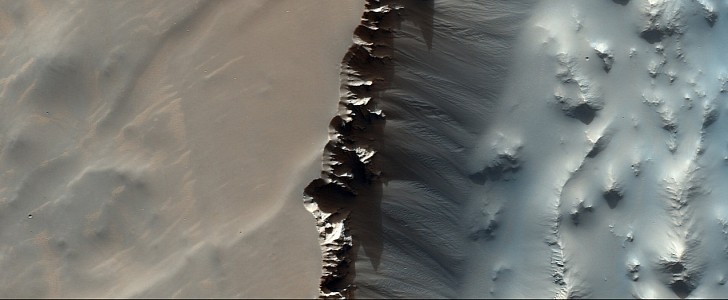At first glance, it appears that something left a deep scar on an alien planet’s face. It’s an image you’d expect to see in a sci-fi movie, but it’s real, and it comes from our neighbor: Mars. What you’re actually looking at is a Martian cliff edge rising above the surface.
This image was taken by the Exomars Trace Gas Orbiter (TGO), a spacecraft that is currently orbiting Mars, mapping its surface and providing not only incredible pictures of it but also a complex inventory of the planet’s atmospheric gases.
The orbiter represents a collaborative project between the European Space Agency (ESA) and the Russian Roscosmos, and its goal is to help scientists trace signs of biological or geological activity and look for water-rich locations.
The orbiter does its job with the help of several scientific instruments. One of them is the Stereo Surface Imaging System (CaSSIS) camera, which the spacecraft uses to capture high-definition images of the Red Planet from 400 km (248 miles) up.
The picture that you’re seeing here (click the main photo to enlarge) was taken over the eastern part of Noctis Labyrinthus, a region that features a labyrinth of valleys and plateaus. It’s located near Valles Marineris, which is the grand canyon of Mars.
The entire network stretches for around 1200 km (746 km), roughly the length of the Rhine River on Earth. It’s a fascinating place that actually looks like wood eaten by termites when viewed from above.
The cliff-like structure that appears to slice the image in the center is part of a “horst-graben system,” ESA says. It resulted from the tectonic processes that pulled the planet’s crust apart, creating raised ridges (horst) and sunken valleys (graben). There’s also rockfall nearby, as well as traces left behind on the cliff face.
Patches of linear ripples formed by the wind can also be seen on the right side of this stunning image. A few minor impact craters appear on the planet’s surface as well.
The orbiter represents a collaborative project between the European Space Agency (ESA) and the Russian Roscosmos, and its goal is to help scientists trace signs of biological or geological activity and look for water-rich locations.
The orbiter does its job with the help of several scientific instruments. One of them is the Stereo Surface Imaging System (CaSSIS) camera, which the spacecraft uses to capture high-definition images of the Red Planet from 400 km (248 miles) up.
The picture that you’re seeing here (click the main photo to enlarge) was taken over the eastern part of Noctis Labyrinthus, a region that features a labyrinth of valleys and plateaus. It’s located near Valles Marineris, which is the grand canyon of Mars.
The entire network stretches for around 1200 km (746 km), roughly the length of the Rhine River on Earth. It’s a fascinating place that actually looks like wood eaten by termites when viewed from above.
The cliff-like structure that appears to slice the image in the center is part of a “horst-graben system,” ESA says. It resulted from the tectonic processes that pulled the planet’s crust apart, creating raised ridges (horst) and sunken valleys (graben). There’s also rockfall nearby, as well as traces left behind on the cliff face.
Patches of linear ripples formed by the wind can also be seen on the right side of this stunning image. A few minor impact craters appear on the planet’s surface as well.





